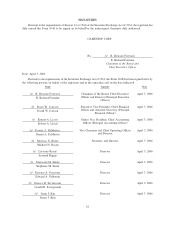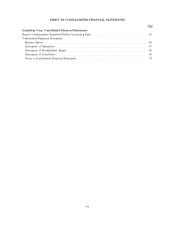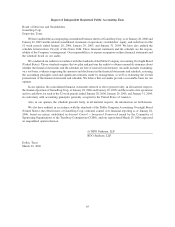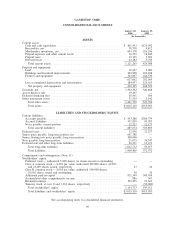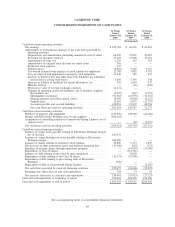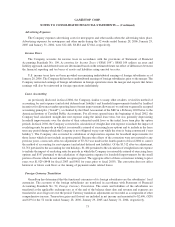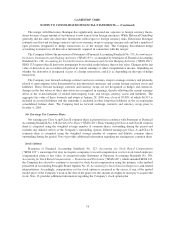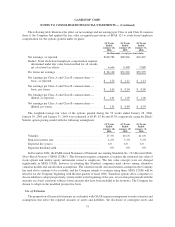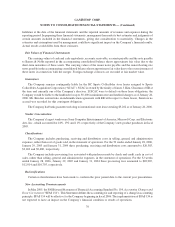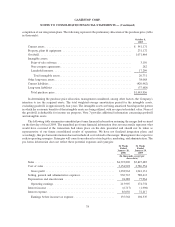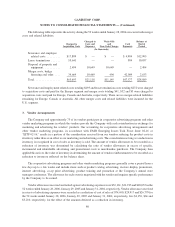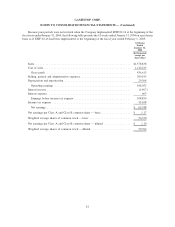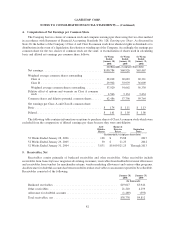GameStop 2005 Annual Report Download - page 81
Download and view the complete annual report
Please find page 81 of the 2005 GameStop annual report below. You can navigate through the pages in the report by either clicking on the pages listed below, or by using the keyword search tool below to find specific information within the annual report.connection with the merger. Goodwill represents the excess purchase price over tangible net assets and identifiable
intangible assets acquired.
Effective February 3, 2002, the Company adopted the provisions of Statement of Financial Accounting
Standards No. 142, Goodwill and Other Intangible Assets (“SFAS 142”). SFAS 142 requires, among other things,
that companies no longer amortize goodwill, but instead evaluate goodwill for impairment on at least an annual
basis. In accordance with the requirements of SFAS 142, the Company completed annual impairment tests of the
goodwill attributable to its reporting unit on the first day of the fourth quarter of fiscal 2003 and fiscal 2004 and
concluded that none of its goodwill was impaired. Through January 29, 2005, the Company determined that it had
one reporting unit based upon the similar economic characteristics of its operations. The fair value of this reporting
unit was estimated using market capitalization methodologies.
Subsequent to the merger, the Company determined that it has four reporting units, the United States,
Australia, Canada and Europe, based upon the similar economic characteristics of operations in those regions. The
Company employed the services of an independent valuation specialist to assist in the allocation of goodwill
resulting from the merger to the four reporting units as of October 8, 2005, the merger date. Additionally, the
Company completed its annual impairment test of goodwill on the first day of the fourth quarter of fiscal 2005 and
concluded that none of its goodwill was impaired. Note 7 provides additional information concerning goodwill.
Revenue Recognition
Revenue from the sales of the Company’s products is recognized at the time of sale. The sales of used video
game products are recorded at the retail price charged to the customer. Sales returns (which are not significant) are
recognized at the time returns are made. Subscription and advertising revenues are recorded upon release of
magazines for sale to consumers and are stated net of sales discounts. Magazine subscription revenue is recognized
on a straight-line basis over the subscription period. Revenue from the sales of product replacement plans is
recognized on a straight-line basis over the coverage period.
Customer Liabilities
The Company establishes a liability upon the issuance of merchandise credits and the sale of gift cards.
Revenue is subsequently recognized when the credits and gift cards are redeemed. In addition, income (“breakage”)
is recognized quarterly on unused customer liabilities older than three years to the extent that the Company believes
the likelihood of redemption by the customer is remote, based on historical redemption patterns. Breakage has
historically been immaterial. To the extent that future redemption patterns differ from those historically experi-
enced, there will be variations in the recorded breakage.
Pre-Opening Expenses
All costs associated with the opening of new stores are expensed as incurred. Pre-opening expenses are
included in selling, general and administrative expenses in the accompanying consolidated statements of
operations.
Closed Store Expenses
Upon a formal decision to close or relocate a store, the Company charges unrecoverable costs to expense. Such
costs include the net book value of abandoned fixtures and leasehold improvements and, once the store is vacated, a
provision for future lease obligations, net of expected sublease recoveries. Costs associated with store closings are
included in selling, general and administrative expenses in the accompanying consolidated statements of oper-
ations. Costs associated with closings of Historical GameStop stores which are directly attributable to the merger
are included in merger-related expenses in the accompanying consolidated statements of operations. Note 2
provides additional information concerning stores to be closed in connection with the merger.
72
GAMESTOP CORP.
NOTES TO CONSOLIDATED FINANCIAL STATEMENTS — (Continued)


